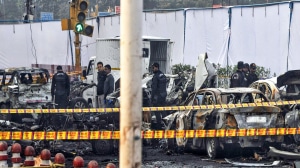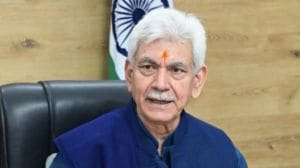Decode Politics: Tamil Nadu parties’ 6-point resolution on delimitation, why they are concerned
The parties have asked the Centre to either base the delimitation exercise on 1971 Census figures or maintain the proportional ratio of states and their Lok Sabha seats based on the 1971 numbers.
 Tamil Nadu Chief Minister M K Stalin. (File Photo/PTI)
Tamil Nadu Chief Minister M K Stalin. (File Photo/PTI)The recent all-party meeting in Tamil Nadu has renewed the conversation on the delimitation exercise.
Led by the DMK and Tamil Nadu Chief Minister M K Stalin, political parties, barring the BJP and its allies, adopted a six-point resolution at the meeting last Wednesday. These are likely to become the focal points of the conversation on delimitation going forward.
The parties have asked the Centre to extend the 1971 Census-based delimitation framework for another 30 years beyond 2026, that is till 2056, and ensure fair representation for states that have effectively controlled their population. On Friday, Stalin wrote to a group of CMs and former CMs of states in southern and eastern India, calling on them to join him in forming a united front against the delimitation exercise.
Stalin warned that the process — if executed as per the next Census — would drastically weaken the political representation of states that have successfully controlled their population.
* What is Stalin’s concern about delimitation?
Delimitation is a Constitutional mandate that is to be carried out after every Census to readjust the number of seats in Parliament and the boundaries of constituencies based on the latest population data.
The idea is to ensure that each constituency has roughly the same number of people living in it. However, following the 1973 delimitation, the number of seats in Parliament and across states have remained frozen. The next delimitation exercise is supposed to happen based on the Census conducted after 2026.
Largely due to the divergent economic trajectories of North and South India, population growth in the South has been far slower than in the North. Thus, if delimitation were to take place based on latest population data, northern states would receive a much larger share of seats in Parliament compared to the South.
The Tamil Nadu Chief Minister emphasised this point in the resolution and said that his state, which has 39 Lok Sabha seats, would face a threat of reduction in its representation due to delimitation.
In the resolution, Stalin said it was “completely unjust for Tamil Nadu and other South Indian states to have their parliamentary representation reduced solely because they have successfully implemented population control measures for the country’s benefit”.
Therefore, the CM called for an assurance from Prime Minister Narendra Modi that the “constituency distribution would continue based on the 1971 population for fairness” and would extend for another 30 years beyond 2026.
Stalin also highlighted that even if the current Lok Sabha strength of 543 seats remained unchanged and the current population figures were utilised to reorganise seats, Tamil Nadu could lose eight parliamentary seats, reducing its representation to 31.
If delimitation is carried out on the current population projections, the strength of the Lok Sabha would increase to 848. But, Stalin argued, Tamil Nadu would gain only 12 seats.
* What does the resolution propose then?
Stalin called for the redistribution of Lok Sabha seats based on the existing proportion of seats that Tamil Nadu holds in Lok Sabha if the strength of the Lower House was increased. In that case, Tamil Nadu’s number of seats would increase by 22, according to the CM.
In essence, Stalin is arguing that Tamil Nadu will lose 10 seats in proportional terms if delimitation is based on the fresh Census figures. This means that even after an increase in the total number of seats for Tamil Nadu in Parliament, its representation vis-a-vis states in the North will decrease in the House.
To counter this, the resolution called for maintaining the proportional ratio of 1971.
“If the number of MPs in Parliament is increased, the Union Government must amend the Constitution to ensure that the distribution of constituencies among states follows the same proportional ratio as in 1971, thereby preserving Tamil Nadu’s rightful representation,” reads the resolution.
* How will the numbers play out?
At present, with its 39 MPs, Tamil Nadu has a share of 7% in the 543-member Lok Sabha.
If the number of seats in the Lok Sabha is increased to 848 — the new Parliament building has 888 seats in the Lower House — it would be on the basis of the delimitation commission fixing an average population of around 16.66 lakh per constituency.
Based on this formula, Tamil Nadu, at projected population of 7.73 crore for 2025, would get 45 seats, effectively reducing its share in Parliament to 5%. A 1971 proportional ratio, however, will give Tamil Nadu 59 seats in Parliament to retain its share at 7%.
Similarly, if the Lok Sabha strength is kept at 543 and delimitation is done based on a fresh Census, the Delimitation Commission would have to take the average base population per constituency at about 26 lakh.
In such a scenario, Tamil Nadu would get only 30 seats, again reducing its proportional representation in Parliament to 5.5%.
* What else has the resolution spoken of?
A key point in Tamil Nadu’s resolution is also against parliamentary representation based on population figures.
“This is not just a matter of numbers— it is a concern for Tamil Nadu’s rights! In this crucial battle, I urge all political parties and leaders to unite. We must set aside party boundaries and raise our voices together against any attempt to reduce Tamil Nadu’s parliamentary representation based on population figures,” the resolution says.
* But can Tamil Nadu oppose population-based delimitation?
As delimitation based on population is a Constitutional provision, changing the parameters of how it is conducted will require a Constitutional amendment.
The 42nd Amendment to the Constitution, passed during Emergency, froze the total number of Parliamentary and state Assembly seats till the 2001 Census.
The present delimitation of parliamentary constituencies within states has been done on the basis of the 2001 Census, under the provisions of Delimitation Act, 2002. However, only the boundaries of constituencies have been altered. The number of seats remain the same and are based on the 1971 Census.
Again, the Constitution was specifically amended (84th amendment) in 2002 to not have interstate delimitation of constituencies till the “first census conducted after the year 2026”.
The only hiccup that the Centre may face in the delimitation exercise is getting a Constitutional amendment passed to increase the total number of seats in Parliament since that will require a two-thirds majority. According to Article 81 of the Constitution, the total number of seats in the House of The People cannot exceed 550.
But resisting an increase in total number of seats could put southern states at further disadvantage since Census-based delimitation at 543 seats could reduce their existing number of seats in the Lok Sabha.






- 01
- 02
- 03
- 04
- 05

























